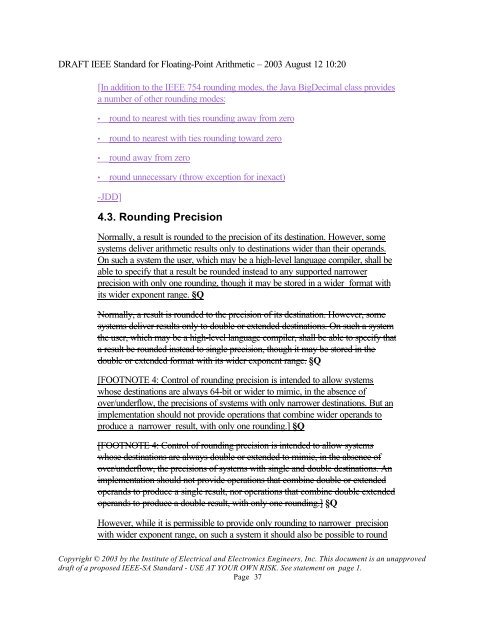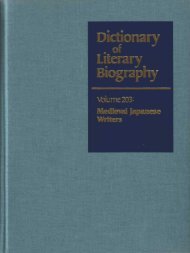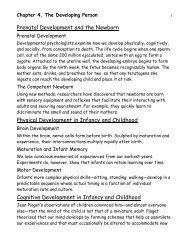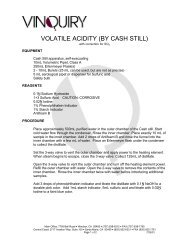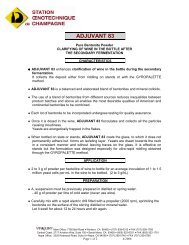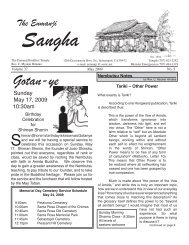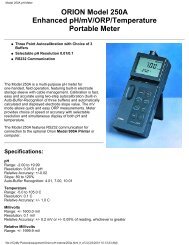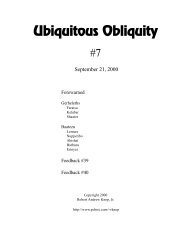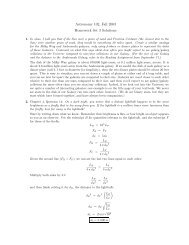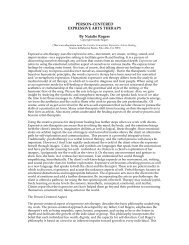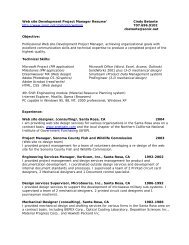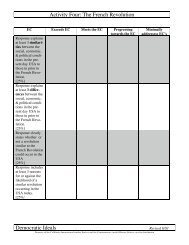DRAFT IEEE Standard for Binary Floating-Point Arithmetic - Sonic.net
DRAFT IEEE Standard for Binary Floating-Point Arithmetic - Sonic.net
DRAFT IEEE Standard for Binary Floating-Point Arithmetic - Sonic.net
Create successful ePaper yourself
Turn your PDF publications into a flip-book with our unique Google optimized e-Paper software.
<strong>DRAFT</strong> <strong>IEEE</strong> <strong>Standard</strong> <strong>for</strong> <strong>Floating</strong>-<strong>Point</strong> <strong>Arithmetic</strong> – 2003 August 12 10:20<br />
[In addition to the <strong>IEEE</strong> 754 rounding modes, the Java BigDecimal class provides<br />
a number of other rounding modes:<br />
• round to nearest with ties rounding away from zero<br />
• round to nearest with ties rounding toward zero<br />
• round away from zero<br />
• round unnecessary (throw exception <strong>for</strong> inexact)<br />
-JDD]<br />
4.3. Rounding Precision<br />
Normally, a result is rounded to the precision of its destination. However, some<br />
systems deliver arithmetic results only to destinations wider than their operands.<br />
On such a system the user, which may be a high-level language compiler, shall be<br />
able to specify that a result be rounded instead to any supported narrower<br />
precision with only one rounding, though it may be stored in a wider <strong>for</strong>mat with<br />
its wider exponent range. §Q<br />
Normally, a result is rounded to the precision of its destination. However, some<br />
systems deliver results only to double or extended destinations. On such a system<br />
the user, which may be a high-level language compiler, shall be able to specify that<br />
a result be rounded instead to single precision, though it may be stored in the<br />
double or extended <strong>for</strong>mat with its wider exponent range. §Q<br />
[FOOTNOTE 4: Control of rounding precision is intended to allow systems<br />
whose destinations are always 64-bit or wider to mimic, in the absence of<br />
over/underflow, the precisions of systems with only narrower destinations. But an<br />
implementation should not provide operations that combine wider operands to<br />
produce a narrower result, with only one rounding.] §Q<br />
[FOOTNOTE 4: Control of rounding precision is intended to allow systems<br />
whose destinations are always double or extended to mimic, in the absence of<br />
over/underflow, the precisions of systems with single and double destinations. An<br />
implementation should not provide operations that combine double or extended<br />
operands to produce a single result, nor operations that combine double extended<br />
operands to produce a double result, with only one rounding.] §Q<br />
However, while it is permissible to provide only rounding to narrower precision<br />
with wider exponent range, on such a system it should also be possible to round<br />
Copyright © 2003 by the Institute of Electrical and Electronics Engineers, Inc. This document is an unapproved<br />
draft of a proposed <strong>IEEE</strong>-SA <strong>Standard</strong> - USE AT YOUR OWN RISK. See statement on page 1.<br />
Page 37


